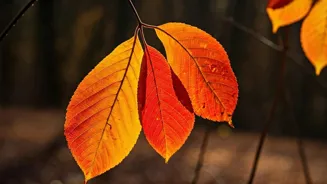Leaves' Color Transformation
The captivating metamorphosis of leaves into their autumnal splendor is intricately linked to both the presence of chlorophyll and the prevailing weather
conditions. During the spring and summer seasons, trees are rich in chlorophyll, the green pigment that helps them capture sunlight for photosynthesis. As autumn ushers in shorter days and cooler temperatures, the chlorophyll production begins to decline. This cessation reveals other pigments, such as carotenoids (responsible for yellow and orange hues) and anthocyanins (which produce red and purple shades), that have been present all along but were masked by the green chlorophyll. These pigments determine the final color of the leaves, with factors such as temperature and sunlight impacting the intensity and duration of the display. The transformation is a complex process, not solely dependent on the presence of pigments, but also on environmental conditions and the tree's specific genetic makeup.
Drought's Effects Explained
Droughts, characterized by prolonged periods of water scarcity, can significantly influence the vibrancy and duration of fall foliage. When trees experience water stress, they may prematurely shed their leaves, resulting in an abbreviated autumn color season. Trees facing drought conditions are also more likely to produce duller colors. The production of anthocyanins, which create red and purple pigments, is specifically sensitive to water availability. In times of drought, the levels of these pigments can be reduced, which then diminish the intensity of the red hues typically seen in fall. Furthermore, stress from the drought could lead to an earlier onset of senescence, the process of aging and eventual death of leaves, truncating the period of vibrant displays. This causes the leaves to turn brown and fall prematurely. Therefore, the lack of adequate water impacts both the brilliance and the length of the fall foliage season.
Impact on Leaf Displays
The impact of drought on fall foliage can vary considerably. The severity and duration of the drought, alongside the specific species of trees and the local climate, play key roles. In regions experiencing intense drought, leaves may turn brown and drop before developing their vibrant colors, essentially bypassing the picturesque phase. Conversely, some regions may see only subtle changes. A moderately dry spell might simply reduce the intensity of colors, making them less vibrant. While drought conditions generally diminish the brilliance of autumn leaves, it’s essential to recognize that other environmental variables also have a significant influence. The amount of sunshine, temperature fluctuations, and the availability of other nutrients are critical contributors to the spectacular display of colors in any given year. This interplay of factors means that even in drought-affected areas, the fall foliage can surprise viewers.
Forecasting Fall Colors
Predicting the precise impact of drought on fall foliage requires a nuanced understanding of various environmental factors. Experts closely monitor precipitation patterns, soil moisture levels, and temperature trends throughout the growing season. The combination of these elements can help create more realistic forecasts of the upcoming fall color. However, weather forecasting is inherently challenging, and predicting foliage colors is even more complex, since it is a combination of multiple factors. The specific tree species within a given area also affects this process. For example, certain species are more resilient to drought and may maintain their color better than others. Thus, while drought can certainly have a detrimental effect, the ultimate display of fall colors will also depend on a variety of other dynamic variables that continue to unfold right up to the season's peak.
Observing Autumn's Beauty
Despite the potential effects of drought, there are still many ways to enjoy the beauty of autumn foliage. Consider exploring local parks and forests to witness the changing leaves firsthand. Staying informed about regional fall color forecasts and peak viewing times helps optimize opportunities for viewing. Also, keep in mind that even during drought years, the display of colors can still be remarkably beautiful. Embrace the opportunity to see the season's natural beauty, and consider the unique aspects and conditions that have influenced it. The variations in the colors will be different from region to region, and some trees may be affected while others will be fine. Understanding the science behind leaf color changes and appreciating the interplay of factors influencing the foliage can enhance one's enjoyment of autumn's beauty.




